NAMM Show with Pics
Posted: Sun Jan 16, 2011 11:11 pm
This was my first visit to the NAMM show in Anaheim, CA. If you don't know, it's a giant trade show for the music product industry. I went with a few band friends, including Mike (thanks for taking the pictures!), who plays on a Besson Eb. He provided some thoughts about the Eb and BBb tubas, while I mainly focused on the CC tubas. I'm not a pro or music major, but just an amateur who really enjoys playing. The reviews are, of course, subjective and in no way try to be "objective" (can reviewing tubas ever be objective?) I also have some concluding (and personal) insights at the end of this post. I hope you enjoy!
Kanstul 90 (CC): I was especially looking forward to this tuba. American-made CC with a special bell alloy that resembles the "York" sound. It definitely has a unique sound that comes out especially in the higher range. I noticed most tubas in the higher range can easily have a "tighter" sound, while the Kanstul tends to be more colorful and warm (has a certain ring to the sound). Very easy to play in all ranges. However, I felt the projection wasn't as good as other tubas (maybe because of the bell, the room, and/or bore size). If I had the opportunity to buy a new all-purpose tuba, I would get this one.
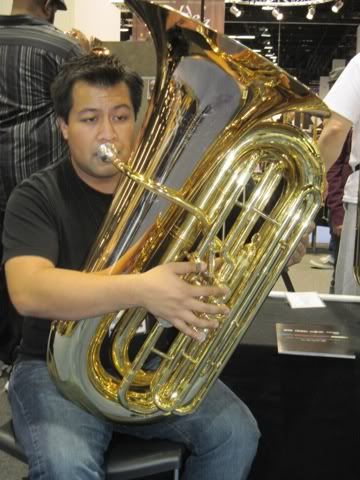
Kanstul 80-S (F): I'm not a F tuba player by any means. So I can't say much about this tuba. Same bell alloy as the 90.
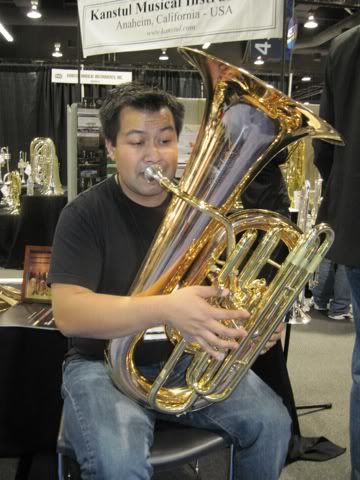
Kanstul 33-T (BBb): Like the 90, the sound is colorful and warm with a decrease in projection. Played within an ensemble (big or small), I bet this tuba would blend in very well. Mike still preferred the King over this one.
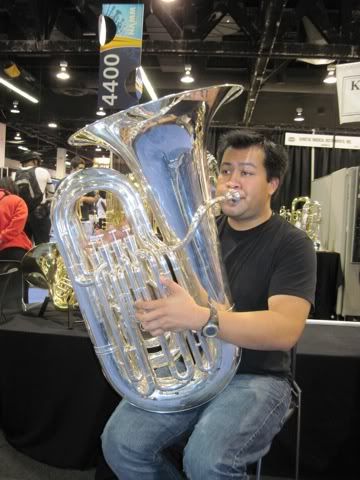
Jupiter 584L (CC): I didn't enjoy this tuba's sound. It has a very tight "German" sound. Direct, not broad. I had trouble slotting with this horn. The low end wasn't as easy as other horns.
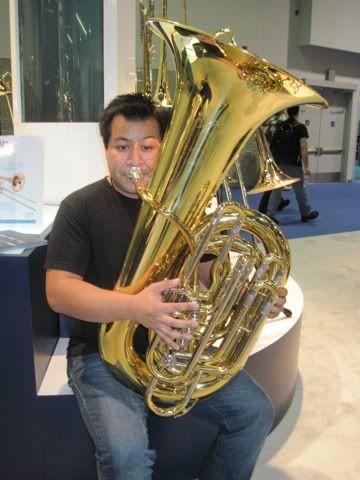
Jupiter 582 (BBb): Similar to the 584. Not horrible, but not really fun to play either.
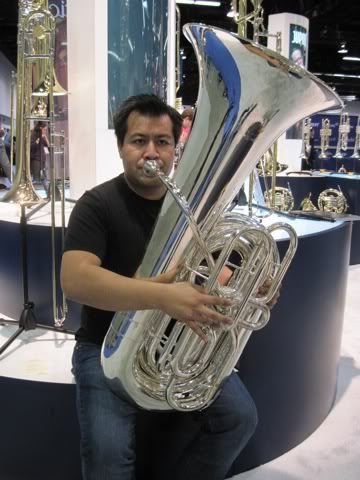
Jupiter Marching Tuba (BBb): Having played in a drum and bugle corps before, I decided to noodle around with the marching tubas. I've marched with Dynasty tubas (built with Willson valve sets). This Jupiter is quite nice. Free blowing. Good weight balance.

King Marching Tuba (BBb): The King rep said this was the latest version of their marching tuba. Compared to their previous version, this new tuba now has a 4th valve and the bell shrunk for more projection. The valves had a spring sound when depressed. Compared to the Jupiter, this was a little more nimble, but the sound was less broad. I think the small bell size makes the sound more direct, thus offering a little projection. I like that there's more space around the tubing so I could actually see my left side while playing.
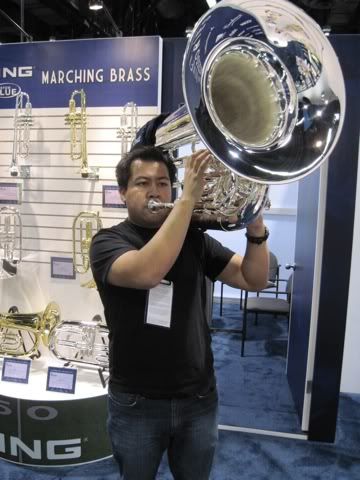
King 2341 (BBb): A wonderful tuba. It has a nice broad sound. Easy playing characteristics. Good range. Along with the W. Nirschl, this was Mike's favorite BBb.
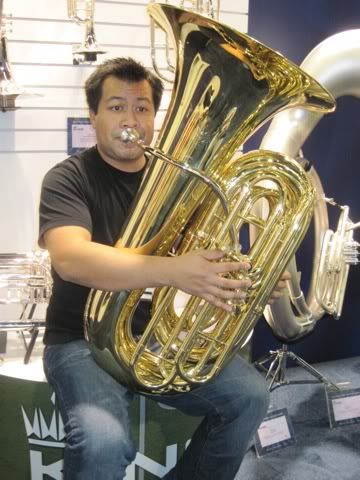
Meinl-Weston 195 "Fafner" (BBb): A 6/4 horn. Massive horn, but good playing response. Mike likened this to his rare 3-valve rotary King that's a similar size. The sound was big and warm.

Meinl-Weston 5450RA "Tuono" (CC): One of their newer tubas, I believe. I think this is their rotary version of the Thor. I love this horn. Great sound, but so easy to play for me. The response is quick! The slotting was impeccable. Great, power sound.
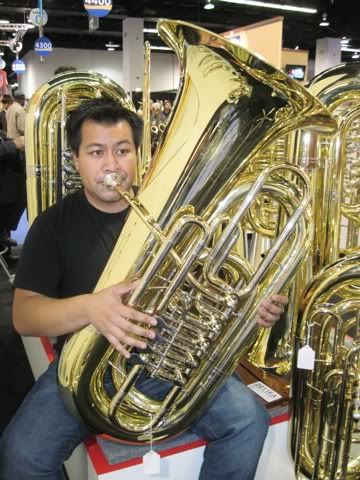
Meinl-Weston 5450 "Thor" (CC): As fun to play as the Tuono, but I think this projected more than the Tuono at the louder dynamics. Very responsive and the sound matches what I like. A good balance between broad and direct.

Besson BE981 (EEb): Mike plays on a similar tuba with a smaller bell (this one has a 19 inch bell). Not surprisingly, this was his favorite tuba. It has a nice, nimble, sweet sound.
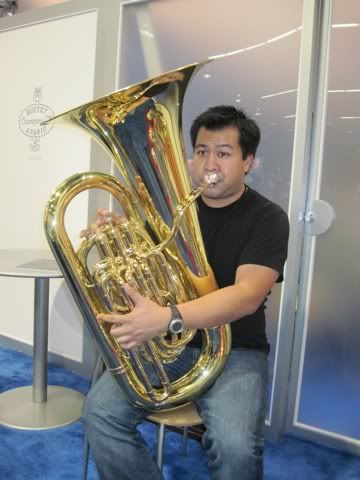
Besson BE983 (EEb): A front action EEb tuba. Mike said the sound is not as good as the upright. I felt more comfortable with the front-action and I, too, thought the sound was little, less colorful.

Besson BE995 (CC): I believe a Nirschl designed horn (looks much like one). I had lots of fun on this one. It sounded most like my current horn (a Conn 2J), but with more "oomph" and depth naturally. Compared to the MW Thor and Tuono, this Besson has less "power" to the sound, but a little more finesse and response. I hope the Brazil-made W. Nirschl CC tuba sounds like this Besson.
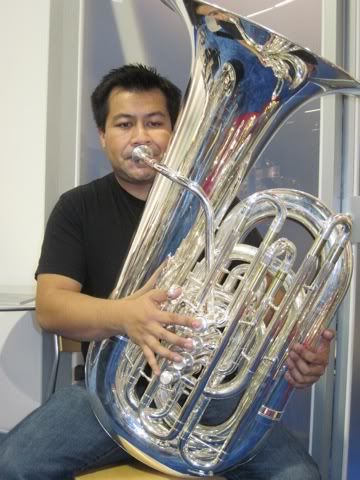
W. Nirschl J-700 (BBb): The Brazil-made tuba distributed by Gemstone/Gemeinhardt. Mike said if he had to take either the King 2341 or this Nirschl, he would take the Nirschl. The sound is colorful and a little "brighter," says Mike. The response is nice. Mike talked with the distributor about the pace of distribution. The distributor said the problems are in the production of the horns. I didn't hear any more details.

Miraphone 1293 (CC): The latest update to the 1291/1292 line of piston CC tuba. The 1293 has a larger bell and larger 5th valve. Like other commenters about the 1293, the low range is very easy to play. Like most Miraphones, this is a reliable tuba with a consistent, mellow sound throughout the range. However, the sound was not my favorite (preferred the Tuono and Thor "power" sound).
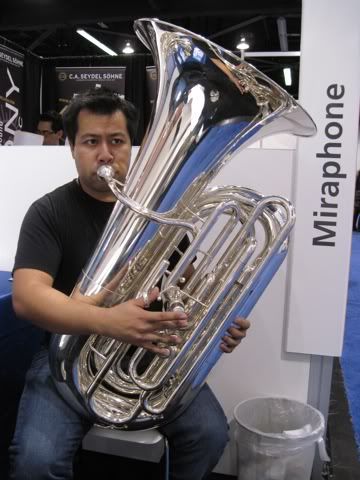
Miraphone 291 "Bruckner" (CC): Compared to the 1291, the sound was a little more mellow, but still not my preference in sound.

Conclusions: I've spent most of my young tuba playing life on one horn, so playing all these tubas made me realize how different each instrument plays. All the playing responses were different in subtle ways that can't be exactly described. Similarly, the sound of each tuba was different. I understand why a preference over a tuba over another can be very personal and subjective. I had a particular tuba sound in my head before I came to NAMM and I found it on the MW Tuono and Thor. If I can buy one 5/4 or 6/4 tuba, it would probably be the Thor. The Kanstul 90 has a unique sound that I can call sweet, warm, and "fat" that permeates throughout the range (not just in the "money" range). Since I play in a variety of ensembles (band, orchestra, quintet), the Kanstul 90 would be a great all-purpose tuba.
As for the Yamaha, they didn't have any concert tubas! They did have a sousaphone, but it was for display only and had no neck. And this is a company that was so big, it needed its own meeting hall in a separate building!
Kanstul 90 (CC): I was especially looking forward to this tuba. American-made CC with a special bell alloy that resembles the "York" sound. It definitely has a unique sound that comes out especially in the higher range. I noticed most tubas in the higher range can easily have a "tighter" sound, while the Kanstul tends to be more colorful and warm (has a certain ring to the sound). Very easy to play in all ranges. However, I felt the projection wasn't as good as other tubas (maybe because of the bell, the room, and/or bore size). If I had the opportunity to buy a new all-purpose tuba, I would get this one.

Kanstul 80-S (F): I'm not a F tuba player by any means. So I can't say much about this tuba. Same bell alloy as the 90.

Kanstul 33-T (BBb): Like the 90, the sound is colorful and warm with a decrease in projection. Played within an ensemble (big or small), I bet this tuba would blend in very well. Mike still preferred the King over this one.

Jupiter 584L (CC): I didn't enjoy this tuba's sound. It has a very tight "German" sound. Direct, not broad. I had trouble slotting with this horn. The low end wasn't as easy as other horns.

Jupiter 582 (BBb): Similar to the 584. Not horrible, but not really fun to play either.

Jupiter Marching Tuba (BBb): Having played in a drum and bugle corps before, I decided to noodle around with the marching tubas. I've marched with Dynasty tubas (built with Willson valve sets). This Jupiter is quite nice. Free blowing. Good weight balance.

King Marching Tuba (BBb): The King rep said this was the latest version of their marching tuba. Compared to their previous version, this new tuba now has a 4th valve and the bell shrunk for more projection. The valves had a spring sound when depressed. Compared to the Jupiter, this was a little more nimble, but the sound was less broad. I think the small bell size makes the sound more direct, thus offering a little projection. I like that there's more space around the tubing so I could actually see my left side while playing.

King 2341 (BBb): A wonderful tuba. It has a nice broad sound. Easy playing characteristics. Good range. Along with the W. Nirschl, this was Mike's favorite BBb.

Meinl-Weston 195 "Fafner" (BBb): A 6/4 horn. Massive horn, but good playing response. Mike likened this to his rare 3-valve rotary King that's a similar size. The sound was big and warm.

Meinl-Weston 5450RA "Tuono" (CC): One of their newer tubas, I believe. I think this is their rotary version of the Thor. I love this horn. Great sound, but so easy to play for me. The response is quick! The slotting was impeccable. Great, power sound.

Meinl-Weston 5450 "Thor" (CC): As fun to play as the Tuono, but I think this projected more than the Tuono at the louder dynamics. Very responsive and the sound matches what I like. A good balance between broad and direct.

Besson BE981 (EEb): Mike plays on a similar tuba with a smaller bell (this one has a 19 inch bell). Not surprisingly, this was his favorite tuba. It has a nice, nimble, sweet sound.

Besson BE983 (EEb): A front action EEb tuba. Mike said the sound is not as good as the upright. I felt more comfortable with the front-action and I, too, thought the sound was little, less colorful.

Besson BE995 (CC): I believe a Nirschl designed horn (looks much like one). I had lots of fun on this one. It sounded most like my current horn (a Conn 2J), but with more "oomph" and depth naturally. Compared to the MW Thor and Tuono, this Besson has less "power" to the sound, but a little more finesse and response. I hope the Brazil-made W. Nirschl CC tuba sounds like this Besson.

W. Nirschl J-700 (BBb): The Brazil-made tuba distributed by Gemstone/Gemeinhardt. Mike said if he had to take either the King 2341 or this Nirschl, he would take the Nirschl. The sound is colorful and a little "brighter," says Mike. The response is nice. Mike talked with the distributor about the pace of distribution. The distributor said the problems are in the production of the horns. I didn't hear any more details.

Miraphone 1293 (CC): The latest update to the 1291/1292 line of piston CC tuba. The 1293 has a larger bell and larger 5th valve. Like other commenters about the 1293, the low range is very easy to play. Like most Miraphones, this is a reliable tuba with a consistent, mellow sound throughout the range. However, the sound was not my favorite (preferred the Tuono and Thor "power" sound).

Miraphone 291 "Bruckner" (CC): Compared to the 1291, the sound was a little more mellow, but still not my preference in sound.

Conclusions: I've spent most of my young tuba playing life on one horn, so playing all these tubas made me realize how different each instrument plays. All the playing responses were different in subtle ways that can't be exactly described. Similarly, the sound of each tuba was different. I understand why a preference over a tuba over another can be very personal and subjective. I had a particular tuba sound in my head before I came to NAMM and I found it on the MW Tuono and Thor. If I can buy one 5/4 or 6/4 tuba, it would probably be the Thor. The Kanstul 90 has a unique sound that I can call sweet, warm, and "fat" that permeates throughout the range (not just in the "money" range). Since I play in a variety of ensembles (band, orchestra, quintet), the Kanstul 90 would be a great all-purpose tuba.
As for the Yamaha, they didn't have any concert tubas! They did have a sousaphone, but it was for display only and had no neck. And this is a company that was so big, it needed its own meeting hall in a separate building!
